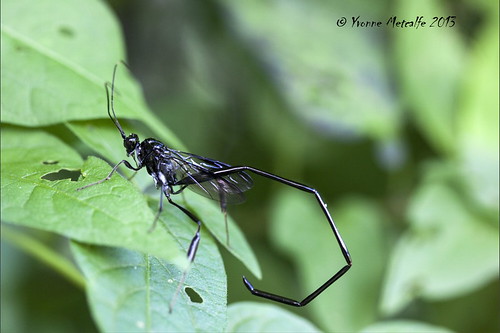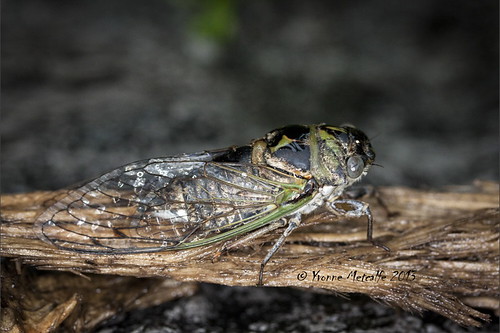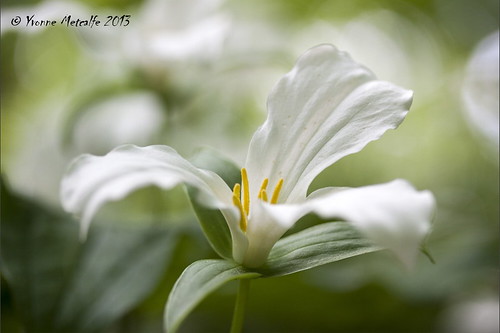The beauty of Autumn is upon us and can easily be found anywhere right now. You don't have to travel far to find the amazing colours that Fall brings. Head down to the lake, take a walk in the woods or simply look in your backyard. I'm sure you'll see some amazing colours that are sure to soothe your soul.
I've been admiring these vines that have crept over my fence from my neighbour's place. I hope you enjoy them as much as I do!
Now get oustide and enjoy some nature!
I have combined my passion for photography with my passion for the great outdoors and all of its amazing creatures and creations.
Tuesday, October 8, 2013
Single Red Autumn Vine
Friday, September 6, 2013
American Pelecinid Female
This beautiful stingless wasp was found at the Earl Rowe campground in Alliston, Ontario. It was at least 1 1/2 inches in length (that includes the tail) if not more. I have never encountered one of these before, so was quite thrilled to capture it!
The male pelecinid wasp is quite rare. What's interesting about this wasp is that the females are able to reproduce without the help of the male. This type of reproduction is called parthenogenisis, which means "virgin birth" . This simply means that the female can lay eggs that don't require fertilization. These unfertilized eggs hatch more females, which explains why this species is predominantly female. For more info on this process, check out this site: http://bioweb.uwlax.edu/bio210/s2012/brummond_jord/reproduction.htm
Monday, September 2, 2013
Dogday Harvestfly on Wood
The Dogday Harvestfly (Tibicen canicularis) is a type of cicada. This one was found in my friend's backyard here in Barrie. Including its wings, it was about 1 1/2 inches in length (about 40 mm).
These creatures cannot sting or bite. It is believed that the dogday harvestfly doesn't even eat. They live underground as wingless nymphs for two to five years.There, they feed on root juices until they are ready to become adults. When ready, they emerge from the dark underground, climb the nearest plant and molt their skin. Once they have climbed out of their skin and their wings have dried, they make their way to the treetops to look for a mate.
You can hear the male cicadas singing in the summer ~ this is how they find their mates!Their call sounds like a circular saw cutting through wood.
I love it when I'm able to photograph these amazing creatures.... they are hard to find (eventhough I hear them all the time).
If you would ever like to find a cicada, the best way to do so is to look on the trunks of trees during the summer. If you are lucky, you might be able to find their empty skin shells (called exuvia). If you this, just look up the tree and see if the freshly emerged cicada is still there. I was lucky enough last year to find four emerging cicadas on a tree as Bass Lake, Ontario. What a thrill that was to watch and photograph!
You can check out my Emerging Cicada post from July 22, 2012 to see pictures of cicada nymphs transforming into adults. Very cool!
Tuesday, August 13, 2013
Milkweed Tussock Moth Caterpillars
I only managed a couple of shots before they fell off the leaf they were on. This is apparently a defense mechanism they use when they feel threatened. My son had bumped the plant they were on and they quickly curled up and dropped to the ground.
The caterpillar will eventually become the Milkweed Tussock Moth (or Milkweed Tiger Moth).
Check out some of these sites to learn more about the Milkweed Tussock Moth and their caterpillars:
Garden Web: http://forums.gardenweb.com/forums/load/butterfly/msg0907431211368.html
Wikipedia: http://en.wikipedia.org/wiki/Euchaetes_egle
The Metropolitan Naturalist:
http://metro-naturalist.com/Animals/Insects/Milkweed_Tussock_Moth.html
Monday, June 3, 2013
Eight-spotted Forester Moth
Not knowing how cooperative it would be, I took a few shots for identification purposes, and then I attempted to pick it up. Turned out that this moth was in a photogenic mood. I love it when they cooperate!
 |
| Don't forget.... you can click on the picture to view me LARGE! |
- Found in the Eastern part of the U.S., Texas and Florida, as well as some parts of Canada
- Found along woodland egdes, in vineyards and in cities
- The adults fly in bright daylight, and this moth is often confused for a butterfly
- Wingspan is about 30 to 37 mm
To learn more about this beautiful moth, check out the following sites:
http://www.butterfliesandmoths.org/species/Alypia-octomaculata: Butterflies and Moths of North America
http://en.wikipedia.org/wiki/Alypia_octomaculata: Wikipedia
Thursday, May 30, 2013
Snail with a Mite
Neat what interesting things you can find when you stop to notice the ordinary.
 |
| A mite has attached itself to this snail's optic tentacle which can also be referred to as a "feeler" |
Sunday, May 19, 2013
Trillium Bokeh
The trilliums were beautiful on my walk today! Some were starting to look a liitle tired already, so if you haven't been out to shoot these beauties, now is the time to do it.
The white trillium is the emblem and official flower of Ontario. It is also the official symbol for the Government of Ontario as well as the official wildflower of Ohio.
It is a common misconception that it is illegal to pick trilliums here in Ontario. This flower is only protected in provincial parks and on lands owned by conservation authorities. There is a rare drooping trillium which is, however, protected by law and illegal to pick. Picking a trillium does do a lot of damage to the plant, and it may take years to be able to flower again.
Instead of picking a trillium to have for a few days, take a picture of it instead and have it forever.
For more information, check out the following links:
http://en.wikipedia.org/wiki/Trillium ~ All about trilliums
http://en.wikipedia.org/wiki/Trillium_flexipes ~ Learn about the drooping trillium here






